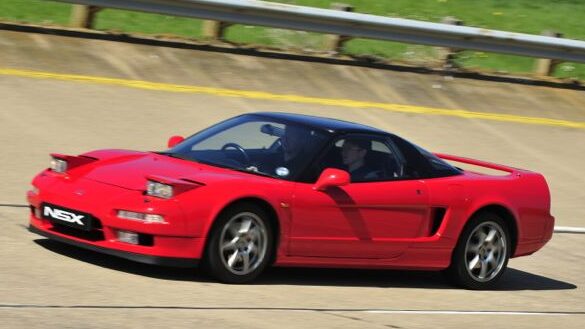‘BACK TO THE FUTURE’ CLASSICS OF THE LAST 30 YEARS
In my series of 12 features entitled ‘Back to the Future Classics’, and appearing on our Western Group’s website throughout 2013, I am looking at a variety of models, differing in character but all held in high regard when launched, and since. I feel that the cars chosen represent “12 of the most significant future classics launched in that time”.
With all the current and quite understandable hype over the forthcoming Honda NSX, it’s appropriate to look back nearly a quarter of a century, to the original model bearing the NSX name.
A hint of what was to come was evident in the Pininfarina-styled, mid-engined HP-X concept car, displayed at the Turin Motor Show in 1984.
The design centred around a lightweight body shell, in which the V6 engine (in this case, a two litre unit) was mounted amidships. During the following years, the NSX was developed towards its production form, with Honda staff determined to make their new sportscar as fast as anything currently available from European manufacturers, but at the same time to instill inherent driving enjoyment, practicality, dependability, reliability and ease of ownership. It is generally accepted that such aspects (especially when considered together) did not always go hand-in-hand with traditional ‘supercars’ of that era…
In arriving at the design on which they eventually settled, Honda engineers drew on the company’s considerable experience in motor sport, and in addition evaluated sporting machinery from a wide range of manufacturers, including (notably) Ferrari and Porsche.
QUALITY
Honda invested heavily in the design and manufacture of the NSX, the aim being to produce a vehicle that was superior in all aspects, compared with the opposition.
In order to optimise the car’s performance and dynamic behaviour, the monocoque body shell was made from aluminium (a first for a production car), and built around an innovative extruded aluminium frame. Extensive use of aluminium was also incorporated into the clever double wishbone suspension set-up, resulting in a low unsprung weight and aiding the car’s handling. Special forged aluminium alloy road wheels also helped in this respect.
Further ahead-of-their time features included electrically operated power steering and a quad channel anti-lock braking system.
At the heart of the car (literally) was a 24 valve, 3.0 litre V6 petrol engine, incorporating Honda’s VTEC variable valve timing system, and developing 271 bhp. Hidden within this jewel of engineering were titanium connecting rods (for example), helping the unit to rev reliably to around 8,000 rpm. Power was delivered to the rear wheels via either a five speed manual gearbox or a four speed automatic transmission.
Performance was considered to be excellent (it still is!), and even in automatic form, an NSX was capable of reaching 60 mph from rest in under seven seconds (manual versions required less than six seconds!), and provided a potential top speed of 158 mph (in manual form, approximately 165 mph). Fuel consumption, typically in the low twenties per gallon, was reasonable, especially considering the car’s performance potential.
During development work, the new car’s handling and roadholding characteristics came under the close scrutiny of a variety of top drivers of the time, including Ayrton Senna, Satoru Nakajima and Bobby Rahal. The NSX was (initially) produced at a purpose-built factory at Tochigi, where the vehicles were in many respects hand-built.
RAVE REVIEWS
The NSX (NA1) was introduced to the public at the Chicago Motor Show in 1989 (initially named ‘NS-X’, but revised to ‘NSX’ before the model went on sale), and at the Tokyo Motor show later that year.
The first ‘wow’ factor was the styling. Most motoring enthusiasts liked the low-slung lines of the car, its retractable headlamps, and its timeless appearance (even today, it looks impressive and modern). From within the vehicle, the deliberately good all-round visibility was another plus point often commented upon, as well as the comfort of the seats and the clear dash layout.
However, it is the way that this car drove that made it even more desirable, for once on the move, its advanced engineering and subtle characteristics could be appreciated by any driver. In addition, the refined manner in which it performed at any speed surprised those used to fast machinery which was usually much less forgiving.
The NSX was fast when required – but smooth-running and relatively quiet at the same time, yet when driven in town, it was as docile as a lamb. In particular, it could trickle along slowly in heavy traffic without drama, happily awaiting the time when it could next be given its head on the open highway. Although the car handled impressively (the stiff chassis, carefully designed and tuned suspension and light weight all helped), it also provided an accommodating, comfortable ride quality that surprised many.
CHANGES
In the summer of 1995, the NSX-T version (below) was introduced, with a removable roof panel, and a revised NSX (NA2) with a slightly more powerful, 3.2 litre engine, a six speed transmission and a host of other changes, made its UK debut early in 1998.
A number of low volume special versions were produced too. Later cars were fitted with conventional headlamps in place of the retractable types on the first NSX models.
By 2005 the end of the production road was in sight for the original NSX, but the model has always been revered for its engineering excellence and its overall combination of qualities. As with Hondas generally, reliability in service has proved to be first class too.
VERDICT
Sensational. One of the most innovative and attractive sporting vehicles of its era; a supercar for sure, yet easy to drive and reliable in service, the NSX has stood the test of time in both styling and technical aspects.

Sensational. One of the most innovative and attractive sporting vehicles of its era; a supercar for sure, yet easy to drive and reliable in service, the NSX has stood the test of time in both styling and technical aspects.

